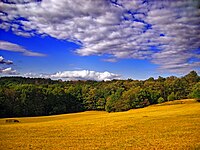
Photo from wikipedia
The edge effect makes forest communities more susceptible to changes and may cause changes in different ecosystem characteristics such as litter production. The objective of this work was to evaluate… Click to show full abstract
The edge effect makes forest communities more susceptible to changes and may cause changes in different ecosystem characteristics such as litter production. The objective of this work was to evaluate the edge effect on the contribution of litter and its temporal variation in a Semi-Deciduous Seasonal Forest fragment located in Vitória da Conquista, BA, Brazil. Four sampling ranges were delimited in the forest fragment: edge (0-10 m from the edge), transition 1 (40-50 m from the edge), transition 2 (80-90 m from the edge) and interior (400-410 m from the edge). The produced litter was collected monthly. The main litter components were leaves and branches in all sampling ranges. The contribution of the other fractions obeyed different orders at the edges (bark > reproductive structures) and interior (reproductive structures > bark). The edge effect did not influence the contribution of total litter and its temporal variation, only manifesting in the production of reproductive structures.
Journal Title: Floresta e Ambiente
Year Published: 2019
Link to full text (if available)
Share on Social Media: Sign Up to like & get
recommendations!